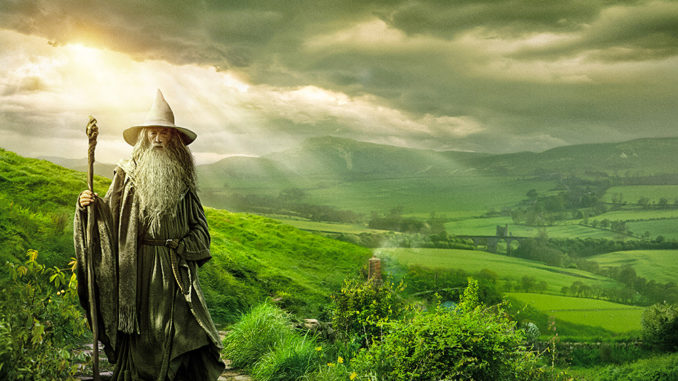
An Inconsistent Journey

(3 out of 5 Shields)
After nine years wait the most exciting part of An Unexpected Journey was the return to Middle Earth. Any fan of J.R.R. Tolkien should watch The Hobbit, but it is a long and inconsistent journey torn between living up to the book and expectations from The Lord of the Rings movies.
Style
![]()
While there are many differences between the style of J.R.R. Tolkien’s works and The Chronicles of Narnia there are also many differences between The Hobbit and The Lord of the Rings. In The Hobbit film trilogy Peter Jackson has managed to take the shortest book and prolong it into a three epic films that strongly embellish the story with additional characters and events. If The Hobbit was left to itself it would make a charming fairytale adventure story, but the success of The Lord of the Rings has trapped the film in a conflict between recreating the feel of those films and being true to the book. This can be seen more clearly in An Unexpected Journey than any other Hobbit films because this movie contains roughly the same number of musical numbers and brutal beheadings. The Hobbit book is naturally more approachable for younger readers and has a lighter tone than The Lord of the Rings. C.S. Lewis’s recognized the fairytale nature of The Hobbit as “merely a fragment torn from the author’s huge myth and adapted for children” (C.S. Lewis’s full review of Lord of the Rings is included in The Reading Life, Image and Imagination, and On Stories and Other Essays on Literature). This difference in style between Middle Earth books is also similar to how each Chronicles of Narnia book has a different style. Narnia screenwriters Stephen Markus and McFeely have commented on this because each book’s uniqueness will not make quite the same type of film. The pressure to make The Hobbit films match The Lord of the Rings is similar to how Prince Caspian and The Voyage of the Dawn Treader films both invented new battle scenes to try and match the climactic battle of The Lion, the Witch, and the Wardrobe which itself was extended to match the style of The Lord of the Rings.
Adaptation
![]()
Bridging the gap between The Lord of the Rings and The Hobbit was done by introducing the backstory of Sauron. While it is fun and exciting to see the return of familiar characters, new characters introduced to the story are not always a welcome addition. I find it a little hard to take the wizard Radagast seriously for being a character with birds nesting in his hair who uses magic to perform the exorcism of the the hedgehog. The film opens with a wonderful homage to The Fellowship of the Ring which then becomes drawn out with unnecessary backstory plot about a new antagonist orc. The addition of this villain to chase down the heroes and add pressure to their quest feels a little too similar to the green smoke monster that was invented as the villain for The Voyage of the Dawn Treader. In both cases the original tone of the book was centered on the pursuit of the quest for its own merits and did not need an antagonist except for squeezing the story to fit the mold of previous films.
Music
![]()
One of the very unique and enjoyable aspects of this movie was the music. This film is unique for being the only Middle Earth film with musical numbers. If the film would have embraced the lighthearted tone of the book these films could have easily been a fairytale adventure that could act as primer for kids not yet old enough to watch The Lord of the Rings. One difference in writing style between J.R.R. Tolkien and C.S. Lewis is the inclusion of songs in the book. In J.R.R. Tolkien’s writings verse can be found throughout the stories. Although song plays an important role in the creation of Narnia, C.S. Lewis never actually writes out the lyrics to Aslan’s song of creation in the way that J.R.R. Tolkien includes poetic verse. In the film songs were not just notable as musical numbers, but their melodies were also incorporated into the score as action themes. The music and score were as stellar as anything you would expect from Howard Shore, but the addition of songs makes this film particularly unique.
Locations
Over the course of my lifetime The Lord of the Rings has transformed New Zealand tourism into the proud home of Middle Earth. This film is adorned with postcard perfect landscapes that are beautiful and picturesque. The magical quality of the landscape is also the reason why several of the Narnia films were also shot in New Zealand. Fortunately filmmakers of An Unexpected Journey decided to establish Hobbiton as a permanent tourist attraction for fans from around the world who travel to New Zealand.
Cast
![]()
One of the strongest and most memorable sequences is a perfect recreation of the iconic chapter “Riddles in the Dark”. In this scene Bilbo Baggins first discovers the ring of power and finds himself matching wits with Gollum in a series of riddles. It is rare that a modern film will take time for long stimulating dialogues, but this scene gets all the attention it deserves. It is a perfect recreation of the chapter. Andy Serkis and Martin Freeman have phenomenal performances throughout the film and their performances make engaging scenes like this possible. The returning performance of Ian McKellen as Gandalf was warmly welcomed as a key part of the film. While there are many many dwarfs on the quest their attention they get on screen is fairly even until later films when focus shifts to characters who have conjured up new romances.
Editing
![]()
One of the overall complaints of this film and the entire Hobbit series is that it is too long. The experience could have been much more enjoyable and truer to the book if it was adapted as one or two movies instead of three oversized films. The Hobbit book went from 272 pages into 474 minutes of film while LOTR went from 1031 pages into 558 minutes of film. If you are interested in watching a compressed version of the film without unwanted plot tangents there is a fan cut of the movie available called The Tolkien Edition. A problem with the film’s gargantuan runtime is that even by the end of the first movie the company of dwarfs feel like they are just beginning their quest.
Innovation
![]()
An Unexpected Journey deserves credit for technical innovation because it was the first film to use a high frame rate film format. This means is that instead of there being 24 images shown every second this rate is doubled to 48 images shown every second. The result is motion that is unmistakably smoother and more lifelike. It was a bold and innovative choice for The Hobbit films, but was also a somewhat jarring change to adjust to. Fortunately this major innovation paved the way for even more lifelike immersive films like Gemini Man that raised the bar to 120FPS. Maybe the next Narnia film will someday be shot using the technology pioneered by The Hobbit.
Conclusion
The first film of The Hobbit is a mixed bag. It must be given credit for technical innovation, music, scenic locations, and a stellar cast. The problems stem from filmmakers trying to force the film to match the shadow of The Lord of the Rings instead of embracing the book for what it is. Embellishments to the story with new subplots bloated the adaptation into three films while loosing the fairytale charm of the book’s inner nature. Narnia film adaptations could easily suffer from this same fate if filmmakers are not careful to embrace the stories for what they are instead making them out into something that they are not meant to be. While the first installment of The Hobbit is torn between following its source material and a grandeur reinvention there is still good to be found wrapped up in an excellent quality production.
